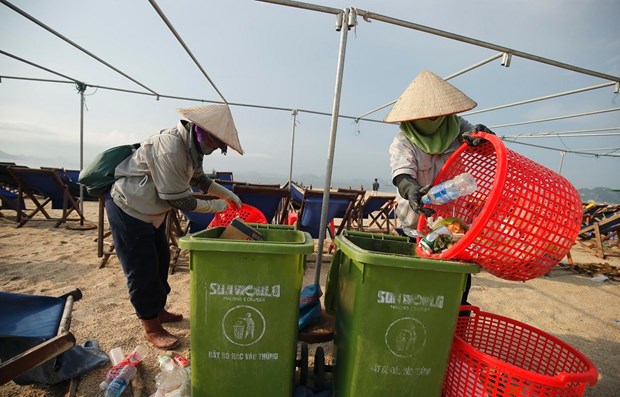Quang Ninh to ban single-use plastics on Ha Long Bay from September 1
 Local trash-collecting workers classify trash on a beach in Ha Long Bay. (Photo: VietnamPlus)
Local trash-collecting workers classify trash on a beach in Ha Long Bay. (Photo: VietnamPlus)
Hanoi (VNA) – Single-use plastic products will be replaced by alternatives made of environmentally-friendly materials by business facilities in Ha Long Bay in the northern province of Quang Ninh, starting from September 1.
Tourism service providers will have to replace plastics with glass, paper, and other environmentally friendly choices, according to Pham Dinh Huynh, a representative of the Ha Long Bay management board, adding that tourists to the world-renowned bay will also be encouraged to limit the use of plastic bags and bottles right from the wharf.
The management board is expected to set up supervision teams to ensure the ban will be effectively enforced.
Businesses and merchants who do not follow the new regulation will receive warnings or administrative fines. Their contracts to provide services in the bay may be ended in more severe cases.
The initiative is hoped to help keep the tourist site clean and maintain the beauty of the scenery in Ha Long Bay, one of the most visited tourist destinations in the country that welcomed around 5.2 million foreigners last year, up 22 percent year on year.
Tourists have shown support to the single-use plastic ban.
Nguyen Hoa Binh, a visitor from the northern city of Hai Phong, told the Vietnam News Agency that he had thrown away all the plastic bottles he carried with to Ha Long right after he heard the information as a way to show his support.
The change can already be seen across the tourism area, as many street food vendors and service providers have already purchased paper cups and straws, and degradable bags in lieu of single-use plastic items.
The Ha Long Bay management board currently works with two trash-collecting units, while nearly 30 local fishing ships also help collect tonnes of trash, most of which is plastic waste, in the waters on a daily basis.
Ha Long Bay’s immense popularity as a tourist destination has been accompanied by a growing trash problem that has reached an alarming proportion.
Currently, an estimated 5,000 wet napkins and as many plastic bottles are used and discarded daily in the UNESCO World Natural Heritage Site. They contribute to 7 tonnes of trash, mostly plastics, dumped into Ha Long Bay waters by the locals and visitors each day.
In the first half of 2019, 573 tonnes – 220 coastal and 353 offshore – was collected from the bay, local authorities said. To collect and deal with this volume, they have spent nearly 14 billion VND (603,700 USD), but this has proved inadequate. Most of the garbage dumped into the bay by residents and tourists are plastic bags and bottles.
Last year, people were shocked to hear that volunteers had collected 741 kilogrammes of waste in just one hour, along two beaches on Ha Long Bay.
Consultants hired by the International Union for Conservation of Nature (IUCN) to give advice on tourism and waste management at the UNESCO heritage site noted that "rapid increases in visitor numbers and pollution have damaged the reputation of Ha Long Bay, especially in the eyes of foreigners".
Seventy percent of the trash, collected from the Coc Cheo and Ang Du beaches, was styrofoam and the rest were plastic bags and bottles, food packaging, fishing nets and clothing, officials said.
Vietnam is the fourth-largest contributor to marine plastic pollution globally, a 2015 study by the University of Georgia showed. The total volume of waste each year in the country comes to about 25.5 million tonnes, of which 75 percent goes into landfills./.













